
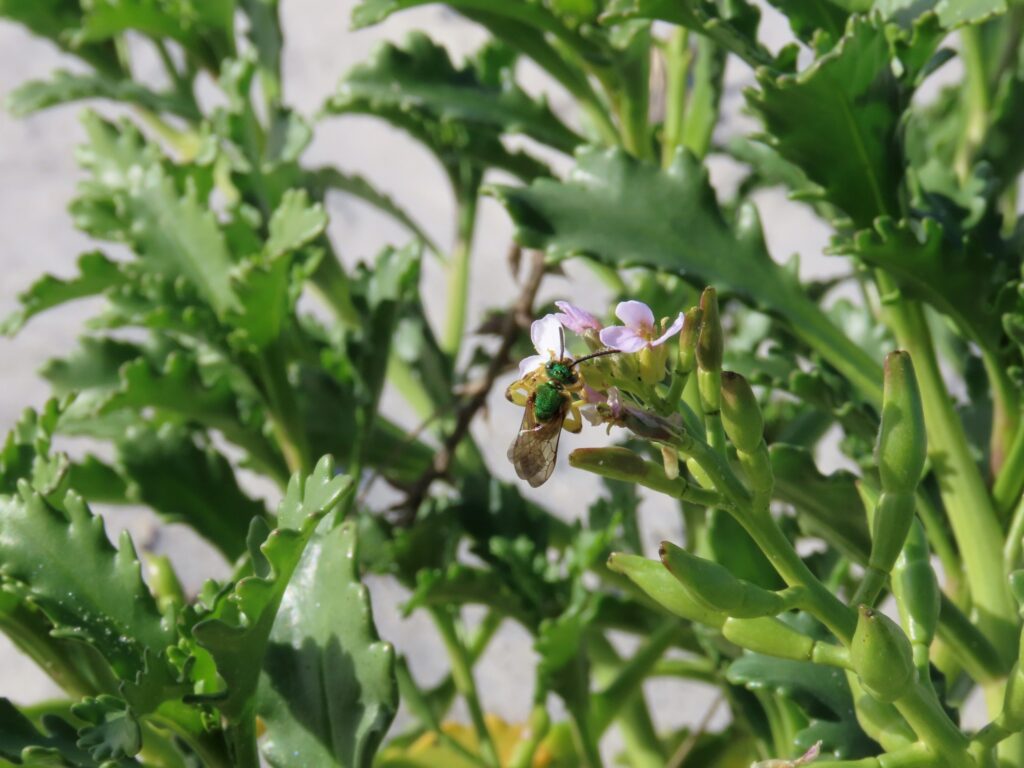
This week for Flora and Fauna Friday, we have a salty, succulent, seaside shrub, American Searocket (Cakile edentula).
Across the coast, over the dunes, and down upon the beach is where you’re likely to spy American Searocket. Searocket is well adapted to this habitat on the immediate coast, and I mean the immediate coast. It is pretty much only found right there on the beach, just above the wrack line, or on sand banks in the mouths of rivers. Searocket is an easy plant to identify. It’s a member of the Mustard family, Brassicaceae, and looks a lot like its condiment cousins. Searocket is compact with a fleshy stem and thick, emerald-green leaves sporting a toothed margin. Its leaves are edible raw or cooked. Searocket flowers are small, four-petalled, and light-pink to white. The flowers are pollinated by a myriad of beach-going insects and mature into a spike of pointed seedpods. The seeds are dispersed both by the ever-present sea breeze and the tides of the Atlantic. Searocket doesn’t like freezing temperatures and can live as either an annual, biennial, or perennial depending on the climate. Here on Edisto, it tends towards the latter two.
You may be wondering what the name “Searocket” has to do with this plant. The term rocket originated from “rochetto”, the Italian word for spools, coils, reels, and other generally cylindrical objects, like shuttles used in weaving. When you look at Searocket, you’ll notice it has cylindrical or “shuttle-shaped” seedpods. Those seedpods are where the plant got its common name. That Italian word was applied generically to radishes, mustards, and the like. Somehow, someway, the term made its way into the English lexicon to refer to this plant and its close relatives, without any of the context. (Sort of like how the German word for “Sea Radish” morphed into the English word “Horseradish”.) Later, when the west first learned of eastern rocket technology, the same Italian term was used to describe those rockets’ shape, which was like a loom’s shuttle. So both rockets and Searockets get their names from that same Italian word, in reference to a distinct shape they have.


This week for Flora and Fauna Friday we have our weirdest and flattest turtle, the Florida Softshell (Apalone ferox).
The Florida Softshell is found throughout Florida, a bit of Alabama, lower Georgia, and up to Edisto and Johns Islands here in South Carolina. It is one of our two species of softshell turtle, the other being the Spiny Softshell (A. spinifera) which is found throughout South Carolina. Of the two, the Florida Softshell is bigger, with females being able to reach two-feet in length. Males are half that size. The Spiny Softshell is more partial to streams and rivers, where the Florida Softshell prefers slower moving waters, like lakes, large ponds, swamps, freshwater marshes, rice impoundments, and even large ditches. The Florida Softshell is a strange looking beast, especially for a turtle. Its face has a long and narrow pig-nose, tall forehead, dark and piercing eyes, long neck, pink skin, and heavy lips that partially hide a dark, “toothy” grimace. Its legs are flabby and flappy and its shell is flat, wide, leathery, and covered in small lumps. However, these characteristics help them adapt to their preferred habitats.
Much like snapping turtles, our Softshell Turtles are ambush hunters. They prefer to lie in wait and let food come to them. They do this by burying themselves in sand or mud in shallow water, leaving only their head poking out. When something comes within range, they use their long neck and strong beak to strike out and grab it. Florida Softshells typically hunt crustaceans, snails, fish, frogs, and any other small creatures that come within range. They also use their long neck to reach up to breathe while buried in shallow water while they use that pointed nose like a snorkel. Those eyes up on top of their head allow them not only to look up out of the water if needed but also to bury their head partially for added camouflage. Their shell, although covered in skin, is still solid bone underneath. However, the edges of the shell lack bones and are hence flexible, allowing them to better navigate tight spaces without getting stuck and providing a better range of motion for their legs. Their flat shell, relatively flexible body, and large webbed feet also make them excellent swimmers, allowing them to cut through swift currents and fast moving waterways. They’re also surprisingly fast on land when they need to be. You’re most likely to spot a Florida Softshell in early summer, when they come on land to lay eggs, or you may catch a glimpse of one sunning along a bank throughout summer and fall.
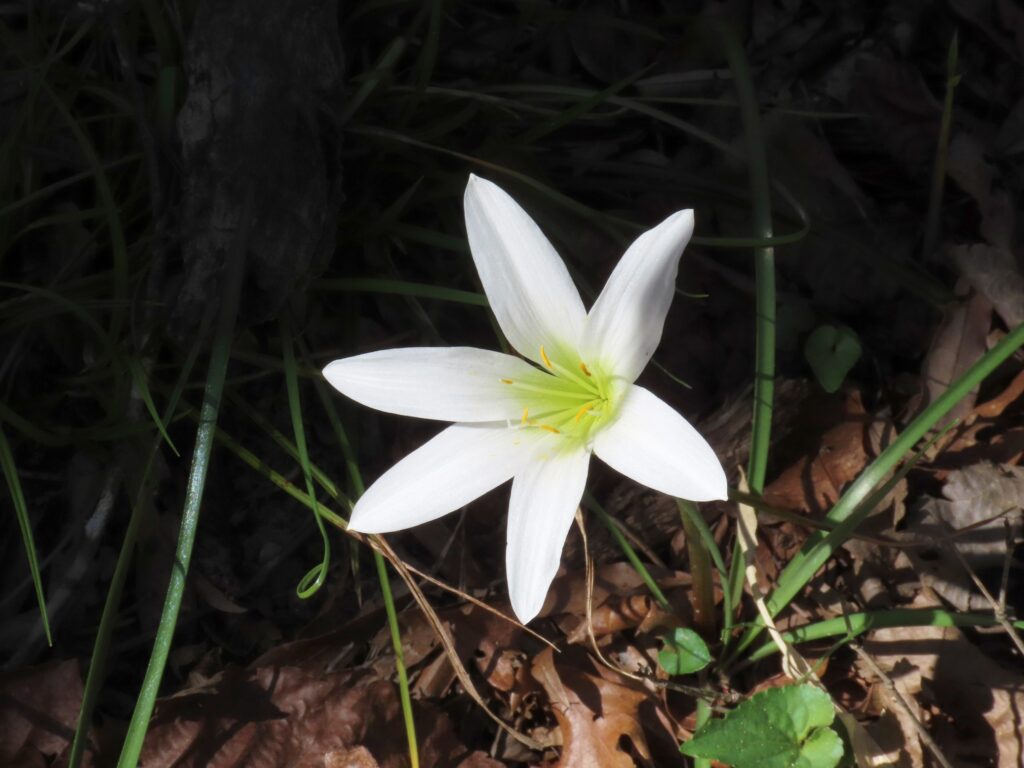
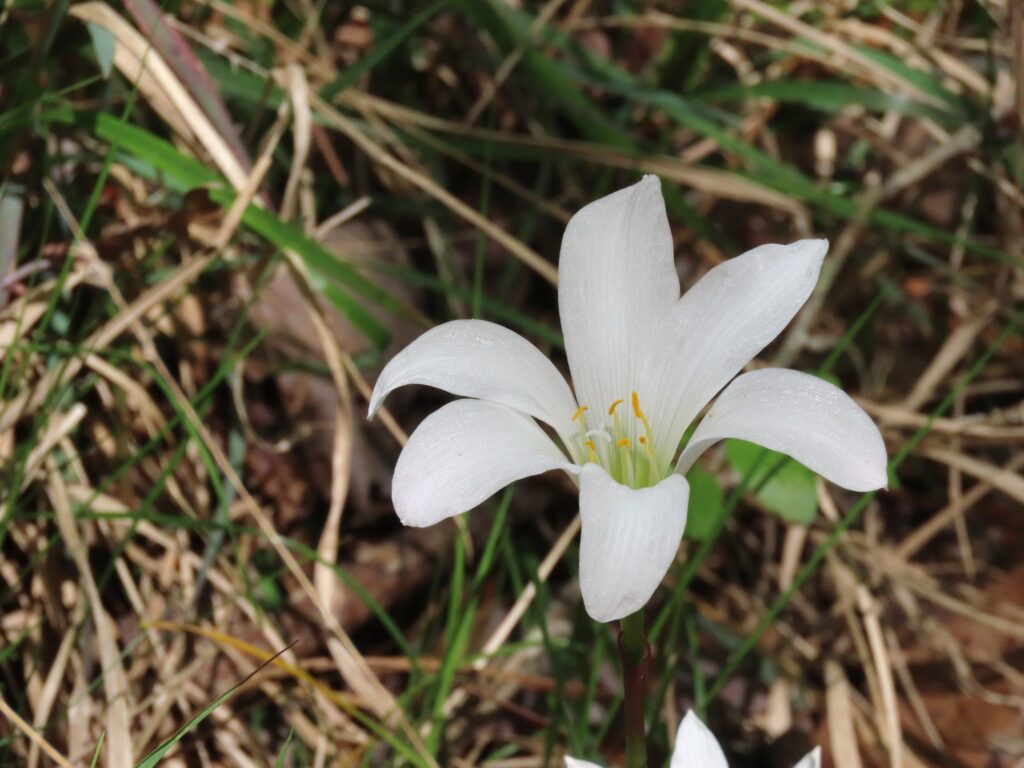
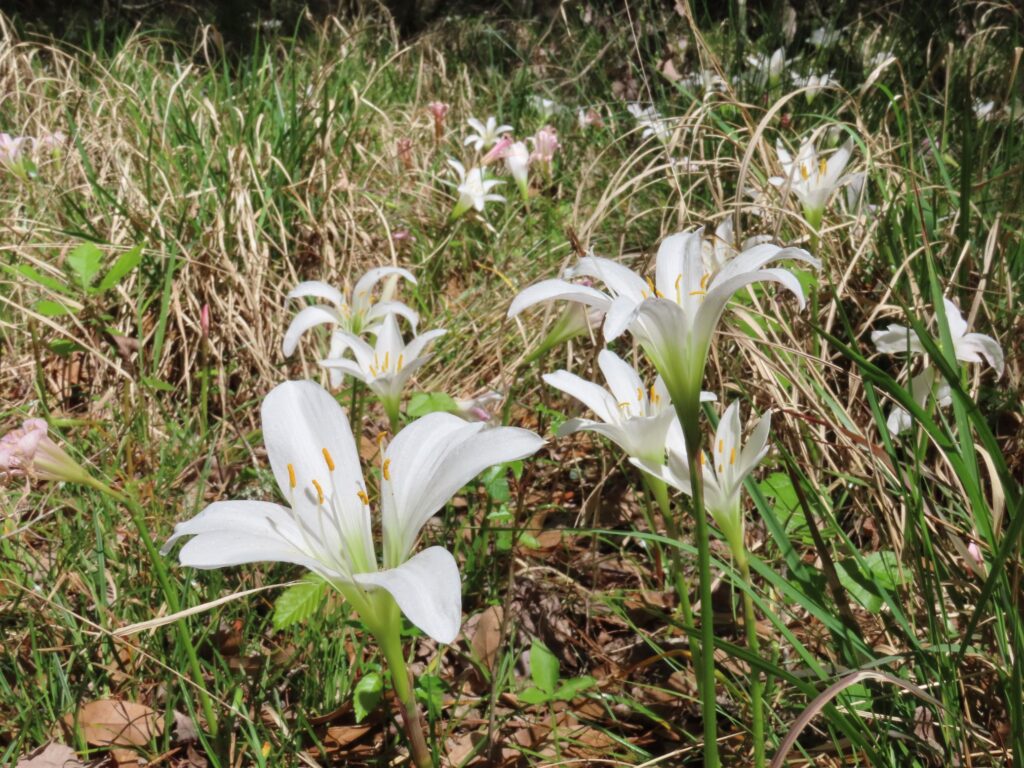
This week for Flora and Fauna Friday it’s our native Easter-time lily, the Rain Lily (Zephyranthes atamasca).
Also known as the Atamasco or Zephyr Lily, the Rain Lily is found across the Southeast, including much of South Carolina. It’s typically found underneath forests along river floodplains or swamps and proliferates most on damp soils in partial shade. Like our other Lilies, Rain Lily is a bulb plant and can tolerate a wide range of site conditions thanks to this bulb. It will also spread to create sparse colonies in good habitat. The Rain Lily’s leaves are thin and grass-like, arching up out of and back down onto the surface of the soil. Rain Lily blooms in early spring, about the time we get our first spring rains, and will continue through April in ideal conditions. Its flowers are a large, ice-white, six-petalled trumpet with golden anthers and a lime-green center. Flowers are usually held pointing straight up and only a foot or so above the ground. Rain Lily is very tolerant of a wide range of soils here in the Lowcountry and can be a great edition to home gardens, reliably providing a burst of spring color every year, like a daffodil or narcissus would. They are also a good pollinator plant, being frequented by many species of large bees and butterflies.
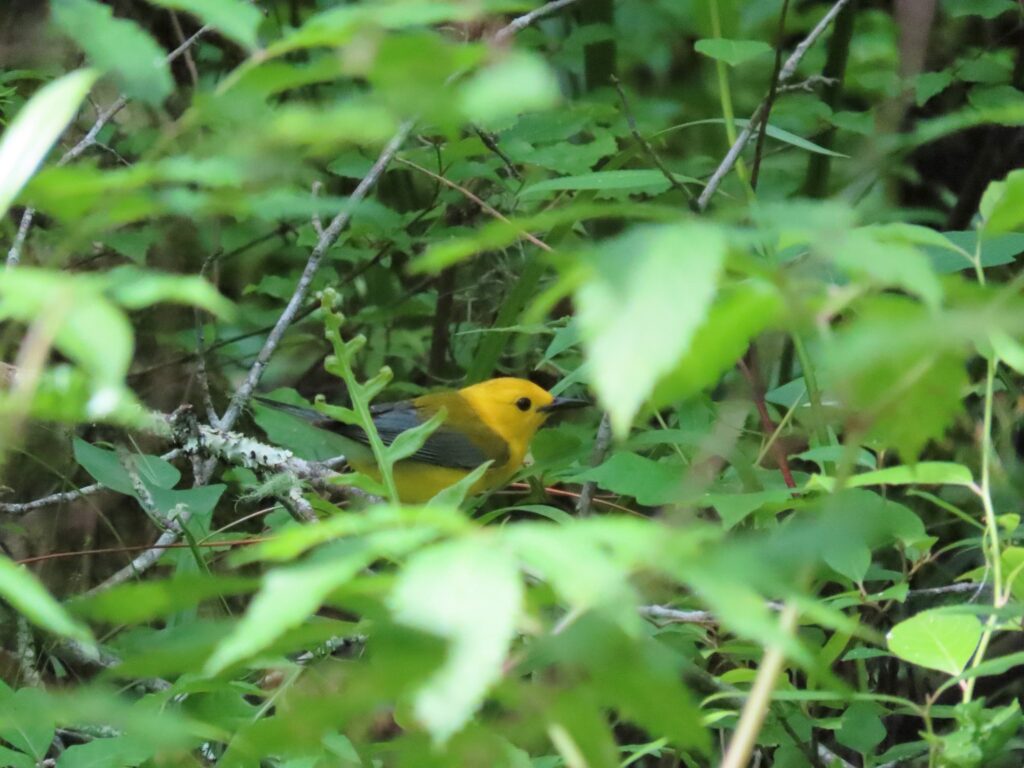
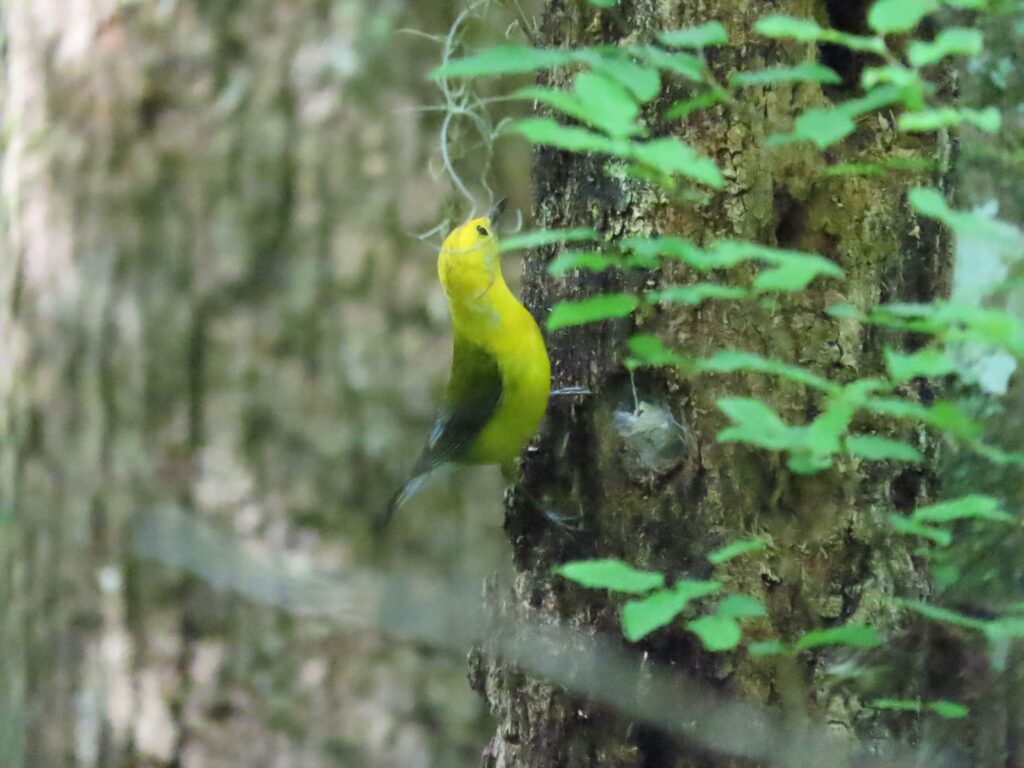
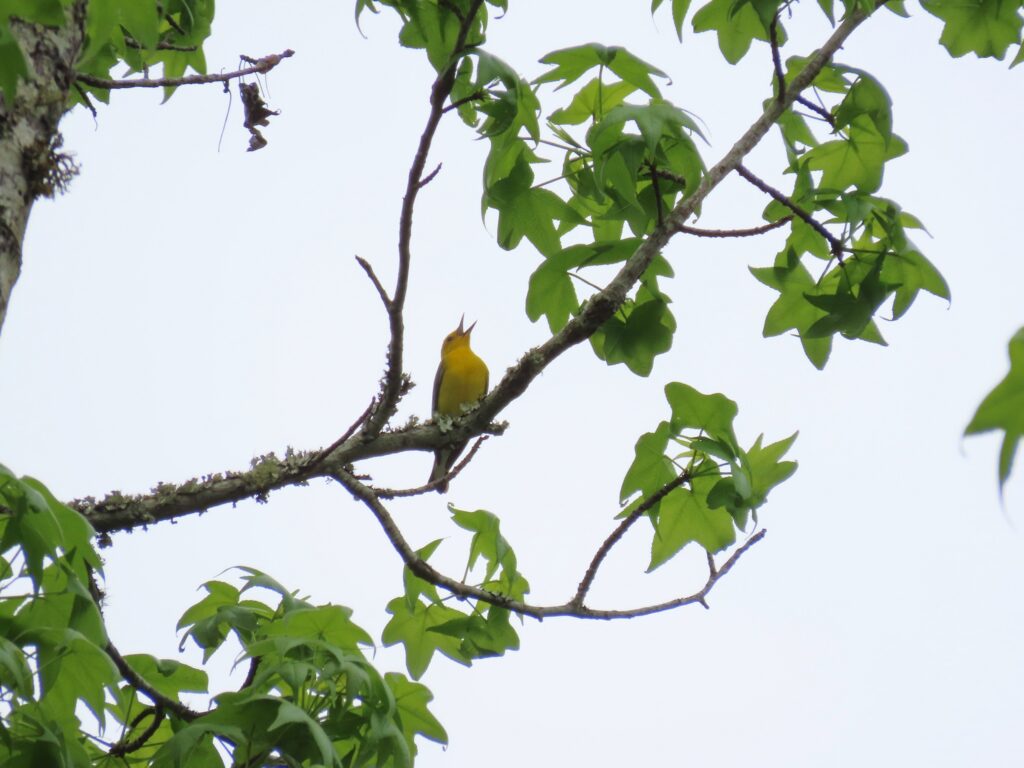
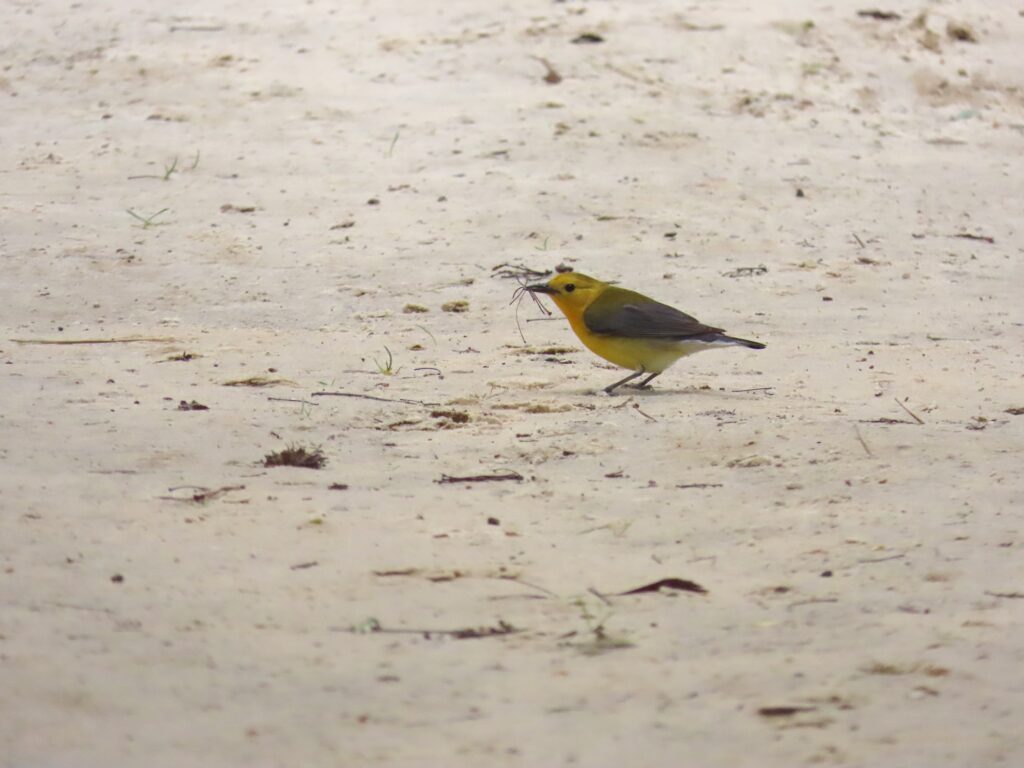
This week for Flora and Fauna Friday it’s the saffron-soaked, sweet-singing songbird of the southern swamps, the Prothonotary Warbler (Protonotaria citrea).
The sounds of summer don’t solidify until the cypress seem to shudder and flutter with the echoes of this bird’s staccato serenade, a series of cyclic “Sweet!” statements spit skyward by this sulfur-stained songbird. This is the sonorous signature our Prothonotary Warbler signs to its swampy abode. Found throughout the East Coast and the Mississippi River basin, the Prothonotary Warbler calls our swamps, bottomlands, floodplains, oxbows, and carolina bays home from spring through summer. It seems wherever one can find abundant cypress, you can spy this warbler. The Prothonotary Warbler is a hard bird to miss as their head and breast positively glow a radiant sunflower-yellow, like the sun bursting through the cavernous and claustrophobic canopy of the swamp. Their shoulders fade to brass and their wings and tail transition to a uniform silvery-black. A beady black eye and pointed black beak poke prominently out from their head.
The Prothonotary Warbler is one of our many migratory warblers but they have some unique traits and fall within a genus by themselves. Like most warblers, they are insectivorous and a leaf gleaners, patrolling the canopy and mid-story for morsels. Their call is a loud, resonant series of repetitive “sweet” notes that can be heard far and wide as the song reverberates between the foliage of the forest canopy and the black waters of the swamp below it. Prothonotary Warblers are our only cavity nesting warbler, using holes carved by woodpeckers to build their nests. So, if you live by a swamp, you may be able to attract nesting Prothonotary Warblers in spring by hanging nest boxes from trees over standing water or by mounting bluebird boxes to the back of free-standing duck nest boxes. These little yellow birds need the help too. Prothonotary Warbler populations have been in decline over much of their range since the 1960s due to historic habitat loss from historic bottomland deforestation, wetland draining, and river damming.
On a final tangent, you’re probably wondering to yourself what in the world prothonotary means. The term prothonotary in the modern United States refers to the title of Clerk of Court, specifically the chief clerk of a court of common pleas, but the term also applied to head scribes, clerks, and other similar positions at various times throughout history. It has long been told that the head scribes or clerks in various incarnations of the Roman Empire wore yellow hooded robes and thus, just like the Northern Cardinal was named after the catholic cardinals who wore red robes, the Prothonotary Warbler was named after these Roman prothonotaries who donned golden-yellow hoods. However, if one digs into history a bit, you find no references to, or paintings of, Roman prothonotaries wearing yellow vestments. If you dig into historical descriptions of the Prothonotary Warbler, you find expert naturalists from over a hundred years ago clueless as to why people call it the Prothonotary Warbler. Some have instead suggested that the term was applied to the birds colloquially by French colonists in Louisiana. Louisiana’s colonial government had an integral public notary system with local chief notaries, who held the title of Prothonotary. Apparently the people who held these bureaucratic positions, which were essential to the colony, developed a reputation for obnoxiously intrusive and repetitive conversational habits. So this yellow swamp bird, with a loud monotonous song that’s prolific in and around the Mississippi delta, is hypothesized to have been affectionately named by French colonists after their inescapable and annoying local bureaucrats, rather than after head scribes in the Holy Roman Empire. This obscure part of French colonial government was eventually lost from common knowledge and so, not having something to pin the name’s origin on, English speaking naturalists turned to the word’s use within the Roman Empire. Then at some point the origin of the birds name was likely conflated with that of the Northern Cardinal. Before you know it, history is rewritten to claim that Roman Prothonotaries wore yellow robes, all because a songbird has a weird first name. Or at least that’s what the competing theory proposes.
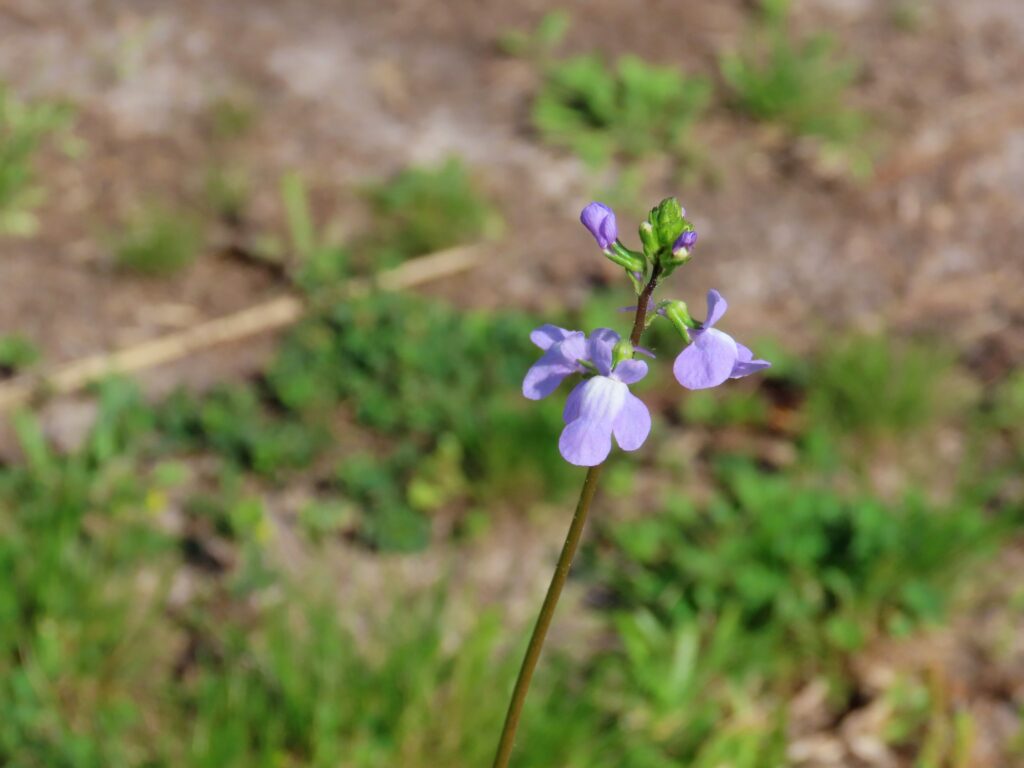
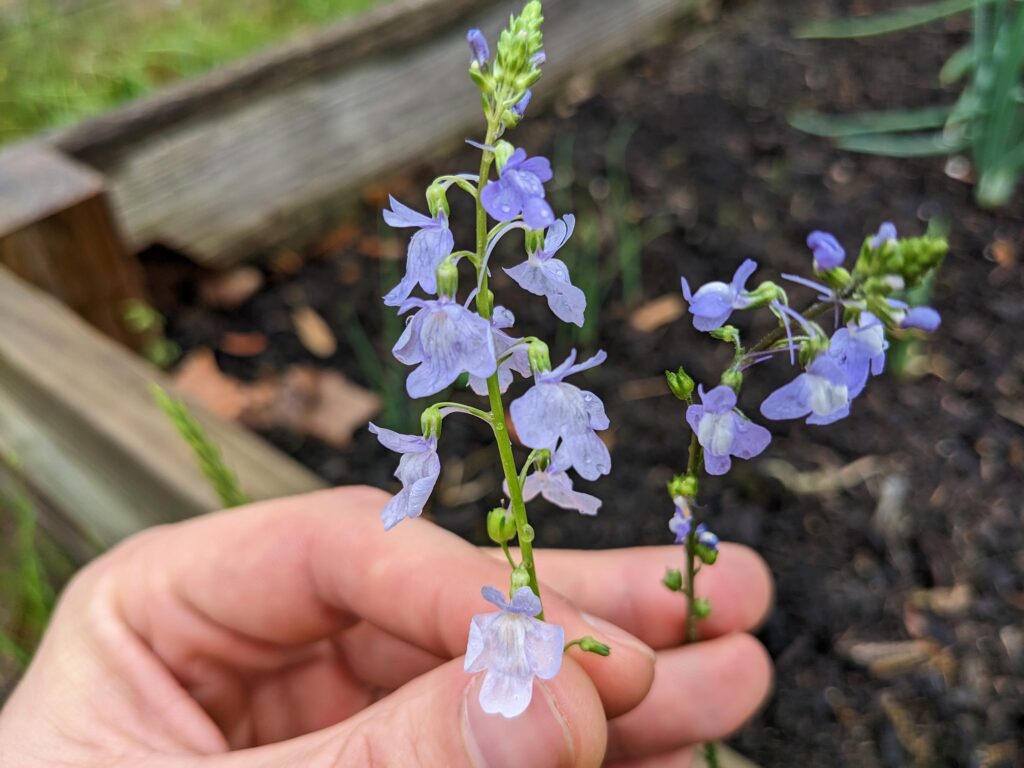
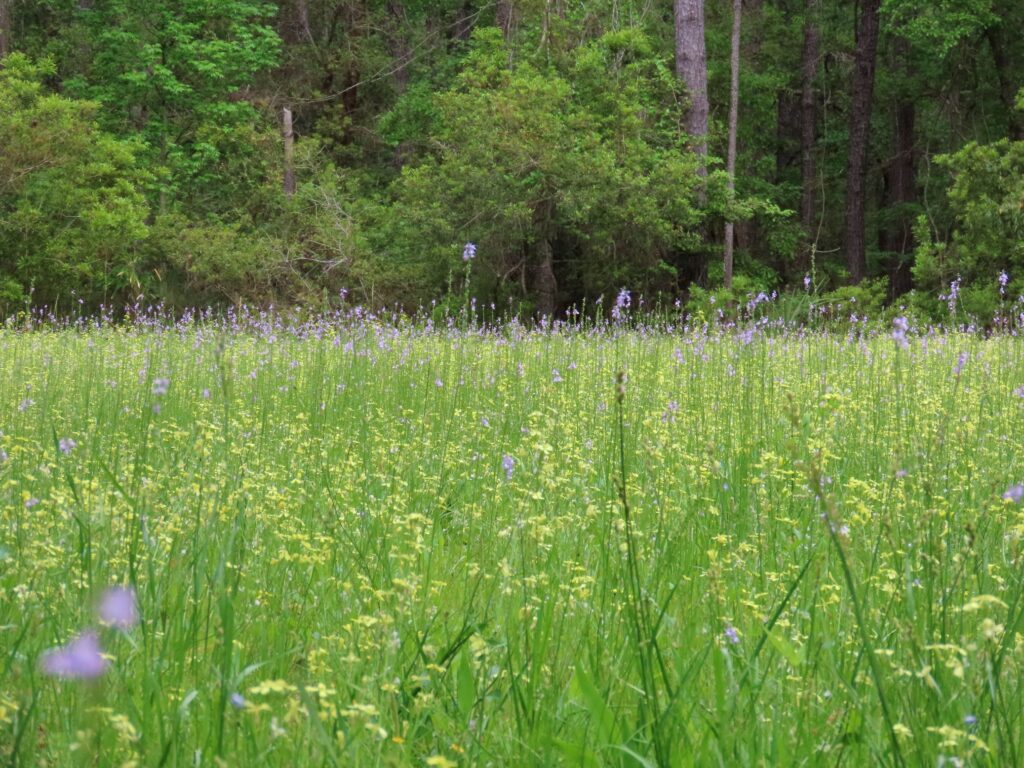
This week for Flora and Fauna Friday we have the bluish beacons of spring fields, Toadflax (Nuttallanthus spp.).
Blue Toadflax (N. canadensis) is found throughout South Carolina and much of the East Coast. Its cousin Texas Toadflax (N. texanus) is common in the western United States but can also be found less commonly across South Carolina. Toadflax are annuals commonly found in sunny open areas and on disturbed soils. Places like pastures, farm fields, roadsides, and lawns. They’re also rather drought tolerant and will crop up on sand ridges, pine-barrens, and dune systems too. Toadflax have small, narrow, pointed leaves that are yellowy-green in color and a nearly succulent texture. They spread laterally with prostrate stems from a central point, forming a clump as they grow. From the center of the clump and from the tip of each stem will emerge flower stalks. These flower stalks typically don’t grow much more than a foot in height and each bears a spike of flowers at the tip. Each flower is snapdragon-like in shape, about a quarter-inch in size, and a subtle blend of white, pastel-pink, and lavender that often blurs into blue or purple at a distance. Blue Toadflax tends to be bluer, with darker shades contrasting its white center. Texas Toadflax flowers tend to be paler, with all colors blurring together, and a bit larger overall. More distinctly the “spur” of the flower, which extends down and back towards the stem, is generally a good fifty-percent longer in Texas Toadflax than Blue Toadflax. However, at a distance, both species look identical. This “spur” is where the flower holds its nectar and, as you might be able to guess, means Toadflax provides food to native pollinators. Its leaves are also the host plant for the Common Buckeye butterfly (Junonia coenia), who’s first brood of caterpillars each year relies on Toadflax for food. As Toadflax seeds are wind dispersed, they colonize new habitats readily and can be spotted blooming just about anywhere dry and sunny in the Lowcountry in early spring. They’re some of the first annual wildflowers to bloom and will often fill up a field or lawn in early spring, briefly setting the entire acreage aglow in an electric-plasma-blue.
Rendering of final restoration by architect Simons Young
FOR IMMEDIATE RELEASE
Mellon Foundation Awards Transformational Grant to the Edisto Island Open Land Trust
The Edisto Island Open Land Trust (EIOLT) will begin the final phase of restoration of the historic Hutchinson House on Edisto Island this year, with the goal of opening both the house and grounds to the public in 2024. The next critical phase of this project is the planning and implementation of a robust and innovative humanities-based interpretation of the site. The Mellon Foundation has just stepped in to help make this next goal a reality, by awarding EIOLT a $950,000 grant to support the interpretation of the Hutchinson House site, including research and exhibit installation, programming, and the hiring of a full-time director.
“This transformational gift is incredibly generous and appreciated. It will provide the resources needed to showcase the Hutchinson House as a centerpiece for telling the full story of the African enslavement, emancipation, land ownership, resilience, and the successes one family was able to attain, on the site where all these things took place”. John Girault, EIOLT Executive Director. A very special thank you also goes out to Barbara Habhegger, who devoted a great deal of her time working on the application for the Mellon Foundation grant request.
The Hutchinson House, listed on the National Register in 1987, represents one of the oldest houses on Edisto identified with the African American community after the Civil War. Henry Hutchinson built the home circa 1885 as a wedding gift for his bride, Rosa Swinton Hutchinson and they lived there until their deaths in 1940 and 1949, respectively. The home stood as a shining example of what could be achieved when a community comes together to persevere and flourish.
Since purchasing the property in 2016, EIOLT’s primary focus has been on saving this endangered historic house from collapse, and then restoring it, as closely as possible, to its original appearance. Stabilization and exterior reconstruction are completed. Funds have been raised to preserve and restore the interior and add back the original wrap around porches and the rear room of the house. It is anticipated the physical reconstruction will be completed by early 2024.
Funds from the Mellon Foundation will be put into action right away, with the recruitment of a full time Hutchinson House Director, who will help oversee the expenditure of this grant award over the next three years.
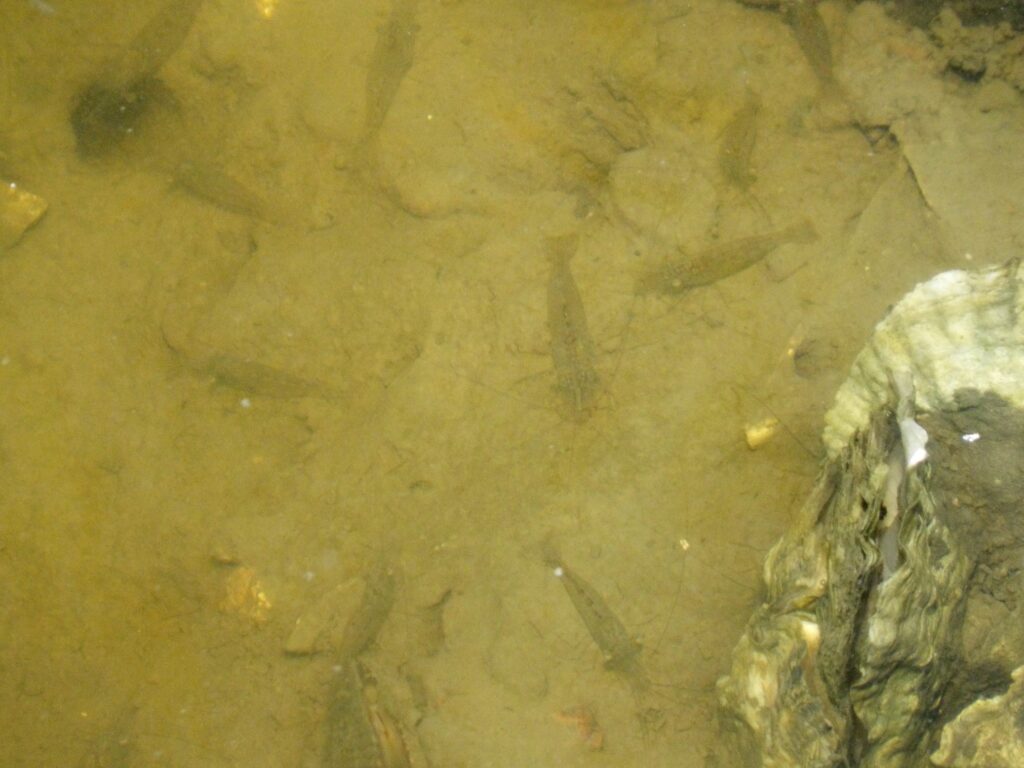
This week for Flora and Fauna Friday it’s our diminutive and delectable denizens of the creek, our edible Shrimp: the Atlantic White Shrimp (Litopenaeus setiferus), the Northern Brown Shrimp (Farfantepenaeus aztecus), and the Northern Pink Shrimp (F. duorarum)
Here on Edisto Island we have three species of edible shrimp, the White Shrimp, the Brown Shrimp, and the Pink Shrimp. The White and Brown Shrimp are far more common, with White Shrimp being the most common. All three of these species are legal to harvest in South Carolina and taste basically the same. They’re all about the same size and look fairly similar too. Overall the White Shrimp is pale-gray with black tail tips, the Brown Shrimp is orange-brown with red tail tips, and the Pink Shrimp is kind of pink, sometimes, but usually more orange and it also, sometimes, has a darker red spot about halfway down its abdomen. There are some other more distinct morphological characteristics that set them apart but I won’t bore you with them here. (We also have a few species of Grass Shrimp, Palaemonetes spp., which are only an inch or two long, translucent, and live in our marshes and oyster reefs.) Shrimp are omnivores and will eat just about anything palatable to them. While young they are predominantly scavengers but become more predatory as they grow larger. Shrimp are an important part of our marine food web as they are eaten by just about everything.
Our Shrimps spend their youth in the estuaries of our tidal creeks before moving out into the shallows of the open ocean as adults. Brown and Pink Shrimps spawn in fall, their eggs hatch within a days or so, the larvae grow into miniature Shrimp, overwinter on the ocean floor, and then migrate into our tidal creeks in spring. White Shrimp conversely spawn in spring and so their larvae don’t overwinter. The larval Shrimp grow over the next few months in their cordgrass cradles. By summer, Brown and Pink Shrimp have reached at least finger length and will begin to head out to the open ocean to finish out their life cycle. White Shrimp will follow suit in late summer and early fall. Many local and regional factors affect a Shrimp’s departure time, chiefly their population levels in the creeks, rainfall upstream, and water temperature. If there are too many Shrimp in an estuary, then they leave earlier and smaller. If there is a lot of rainfall on the uplands there will be an excess of freshwater coming downstream, which will push our salt loving Shrimp out to sea earlier. If the shrimp aren’t overcrowded or if there is little rainfall, they may stay a month or longer in the creeks until water temperatures drop. Shrimp have short lifespans and rarely live for more than a year.
Shrimp are the most popular and profitable fishery in South Carolina as well as the whole United States. Shrimp are harvested commercial mainly with offshore trawling boats in summer and fall. Shrimp are also an extremely popular recreational fishery, open to South Carolina saltwater fishing license holders from May to mid-December. Shrimp aquaculture was once a burgeoning new business in the Lowcountry. In the 1980s, many shrimp farms popped up south of Charleston, with even a few on Edisto Island and along Toogoodoo Creek. These farms grew Shrimp in saltwater ponds for retail sale and many were profitable for a brief time. However on farms using tidal ponds, the potential for shrimp diseases to concentrate in the ponds and then be discharged into the estuaries, where this could harm native Shrimp populations, became a concern of the State. Additionally, heavy competition from overseas shrimp farms quickly appeared. These two factors halted and reversed the industry’s growth in South Carolina. By the mid-2000s, the shrimp farming industry had all but vanished from the Lowcountry and only a few farms still operate in South Carolina today.
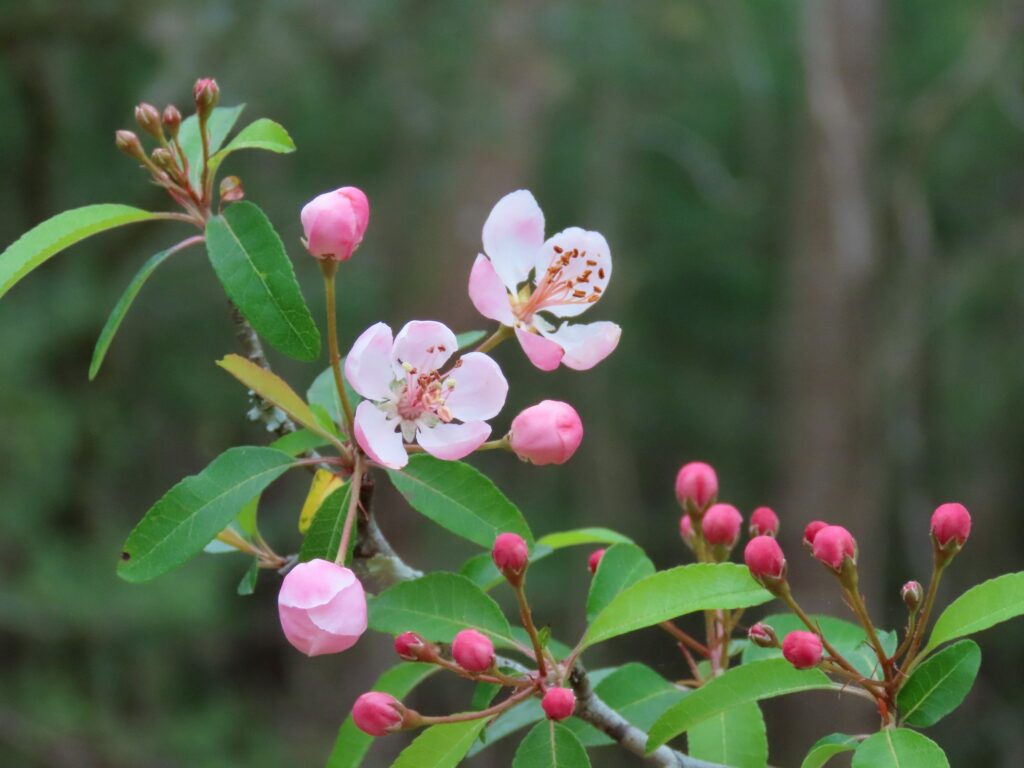
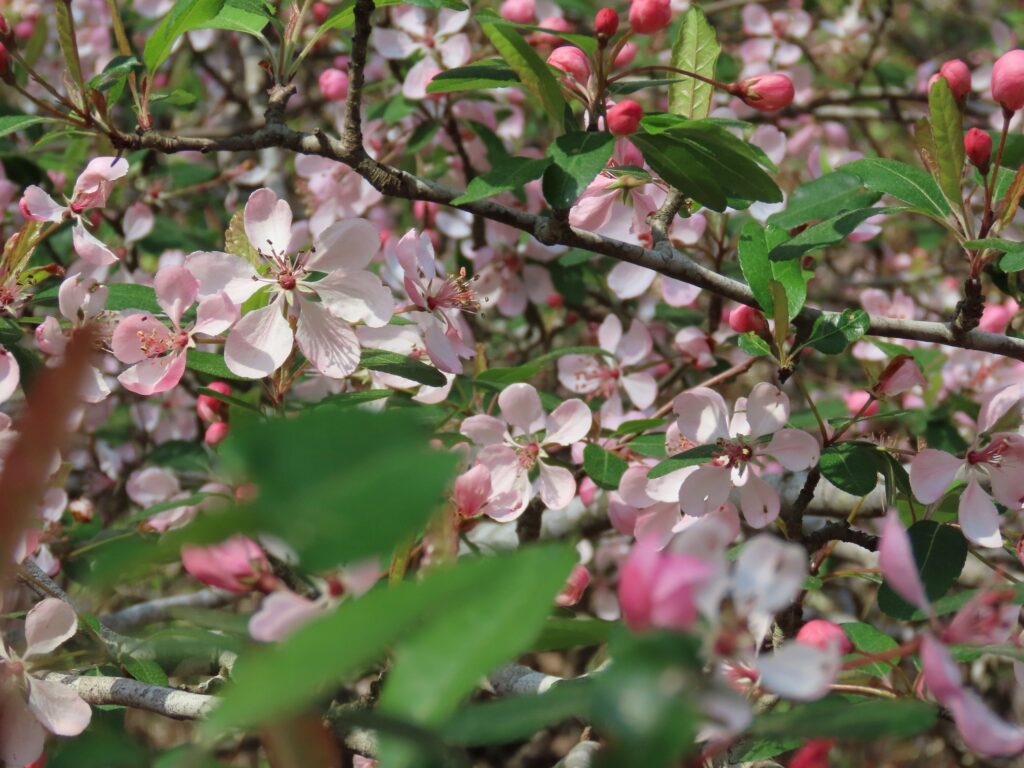


This week for Flora and Fauna Friday we learning about the lesser known cousin of the prototypical fruit tree, Southern Crabapple (Malus angustifolia).
Southern Crabapple is a member of the Apple genus found throughout the Southeastern United States. In South Carolina it’s primarily seen within the coastal plain. It’s a large shrub bordering on small tree that’s partial to moist but well-drained soils along woodland edges and clearings. It will spread by its roots to create loose thickets but primarily disperses through seeds carried away by wildlife. Southern Crabapple has dark scaly bark and a compact growth form with a broad canopy. Its leaves are small, simple, and possess a toothed margin. Its stems occasionally are barbed with thorns. The stems of Southern Crabapple also have a feature called “spur twigs” which are short, thickened twigs growing from the side of the main stem. Spur twigs are an adaptation found mainly in fruit-bearing trees and these stems are where the flowers and fruits of the plant primarily emerge from. These spur twigs only grow a few fractions of an inch each year and, by staying short and thick, they keep the fruits close to the main vegetative stem. This lowers the overall weight of the limb and reduce strain on the limbs from wind. Thus helping prevent limb breakages when the plant is laden with fruit.
The easiest time to find a Southern Crabapple tree is in early spring, usually the latter half of March, when they let loose their buds and produce a profusion of flowers. The entire tree becomes smothered by a blanket of pale-pink petals. There are few other native trees that are as prolific a bloomer as Southern Crabapple. Like many fruit trees, these flowers rely on bees and other native pollinators to set fruit. The fruit of the Crabapple, as well as regular Apples, is a pome, a soft, fleshy fruit with several seeds tucked into its center. The fruits of Southern Crabapple are small, at about an inch across. They’re also hard and practically inedible for humans. However, the fruits can be cooked down to make preserves or fermented to make ciders. Additionally, these fruits are cherished by wildlife including deer, raccoons, foxes, turkeys, orioles, and mockingbirds. Southern Crabapple is commonly planted in food plots as means of attracting wildlife. There are many cultivars that have been developed for this native shrub in order to boost the value of its fruit for both wildlife and human consumption as well as to make it hardier or more ornamentally attractive.

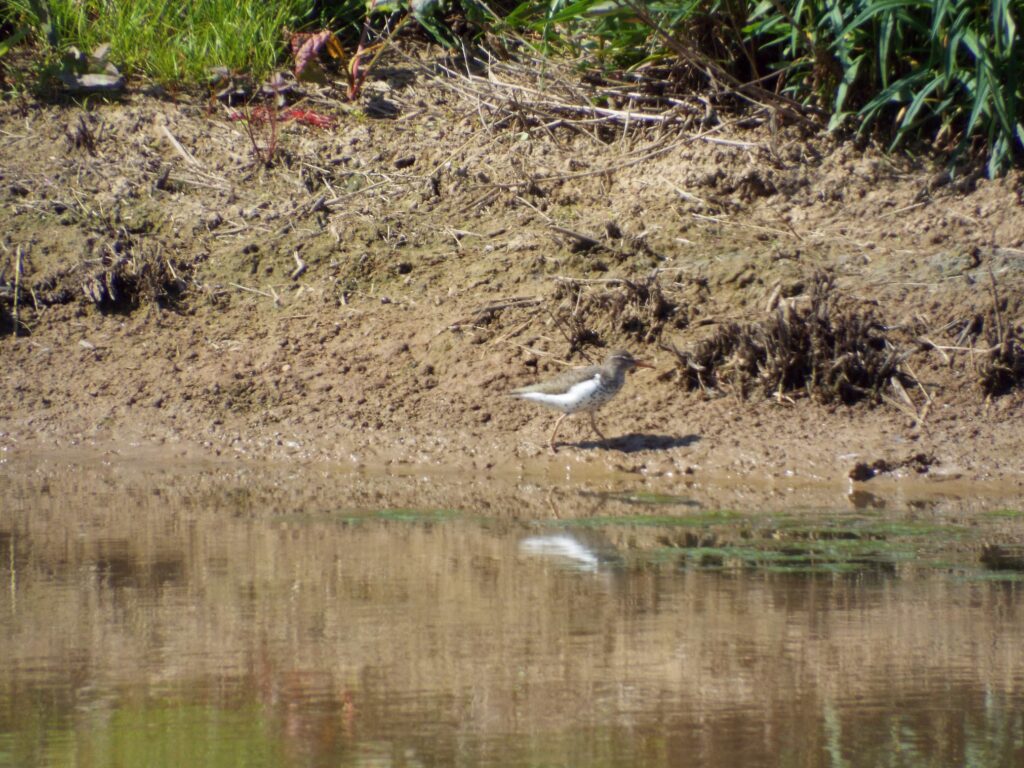

This week for Flora and Fauna Friday it’s our one and only tail-wagging resident shorebird, the Spotted Sandpiper (Actitis macularius).
The Spotted Sandpiper is a common shorebird that can be found throughout South Carolina. Most bird guides will tell you they are found around coastal South Carolina only during the winter, but here on the Sea Islands, we can spot these speckled shorebirds year-round. They solitarily patrol the shores of lakes, ponds, and tidal creeks across their range, where they probe the sediment for invertebrates and snack on any critters that linger on the surface. Here on Edisto, they’re most commonly found on the banks of tidal creeks and gutters at low tide or perched on docks and piers when the tide comes in. Spotted Sandpipers are hard to ignore as they often launch from the shore while uttering shrill, 2 or 3 note calls as they frantically fluctuate from fluttering to gliding just inches over the surface of the water. However, getting a good look at one while it’s still on the ground is a bit harder due to how skittish they are. But, when you do, they’re an easy bird to pick out.
The Spotted Sandpiper is a smaller shorebird, bigger than most peeps but smaller than a Red Knot or Ruddy Turnstone. The Dunlin is the closest size for comparison. Their bills and legs aren’t short but they aren’t really long either. Their neck is longer than most peeps but proportionately shorter than Yellowlegs or Willets. Given their unusually intermediate proportions, few other shorebirds resemble their physique. More distinctly, they have big eyes accentuated by a dark eye-stripe and white eyebrow. In summer, their most distinguishing feature is obvious, their spots. The Spotted Sandpiper in its breeding plumage sports an apron of dark spots from its chin down to its thighs. When the spots are there, there’s no mistaking them. Yet in winter their spots vanish, leaving behind a pure-white, unmarked underside and a uniformly grayish-brown back. Apart from physical appearance, they also have another behavior that is a dead giveaway for the species. The Spotted Sandpiper is one of our select few bird species with a habit of tail wagging and is the only one of our shorebirds that tail-wags. For the Spotted Sandpiper, it wags its tail downward, bobbing its whole body up and down as it walks and stalks.
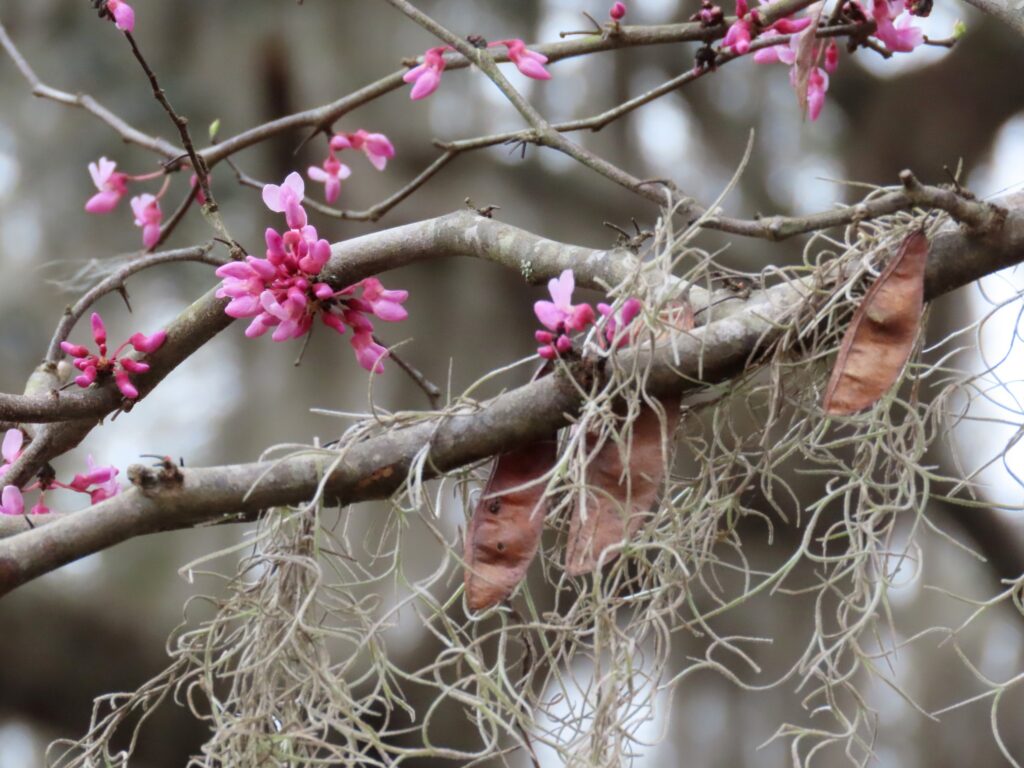

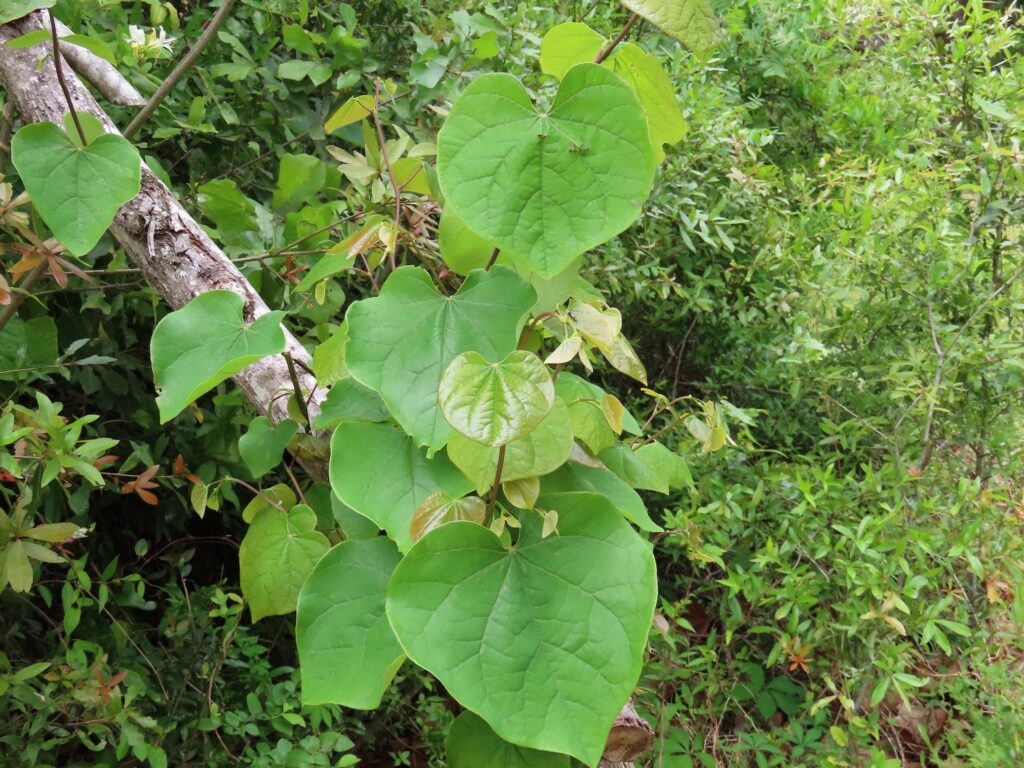

This week for Flora and Fauna Friday we have the black sheep of the bean family, Eastern Redbud (Cercis canadensis).
Redbud is one of our largest native legumes, meaning it’s a member of the bean family. It’s a small tree, growing twenty to thirty feet in height. It’s found throughout the eastern United States and in every corner of South Carolina. Every year at the eve of winter, Redbud graces us with its presence. Smoldering hot-pink flowers burst forth from its bark, setting the leafless tree aglow. Strangely, these flowers emerge not just from the twigs but from the larger stems and even the main trunk of the tree and they appear in dense clusters, sometimes packed so tight that flowers become buried beneath each other. Each individual flower is about a quarter-inch in size with that classic pea-flower shape. The leaves of Redbud emerge after it flowers and grow into palm-sized, heart shaped leaves. The new leaves often appear as lime-green or purple-red in color, especially at the branch tips, before maturing into a uniform verdant shade across the plant.
Redbud has several traits that make in unusual for a legume. One, it’s a full-fledged tree where nearly all of our native legumes are forbs, vines, or shrubs. Two, it is fairly shade tolerant and will even grow in the forest understory, whereas most legumes need full-sun. Three, it does not fix nitrogen. Legumes are renowned for their proclivity towards forming mutualistic relationships with soil bacteria in order to capture atmospheric nitrogen, allowing them to grow well on weathered soils where little else can. Yet, Redbud doesn’t have any special adaptations to do this. Despite its quirkiness, Redbud makes for an excellent native plant for ornamental use in yards and urban landscaping. It will grow well with little maintenance on a wide range of upland soils in a multitude of lighting conditions. When young, it can be pruned as a handsome shrub and, when mature, becomes a broad, arching shade tree. We also can’t forget the stunning profusion of flowers. Redbud is one of the first trees to bloom, usually starting in late February on Edisto Island. Bees and other early pollinators make good use of these flowers too, so they’re not just for show. Redbud is a great addition to most any native landscaping initiative and is commonly planted across South Carolina as a result.